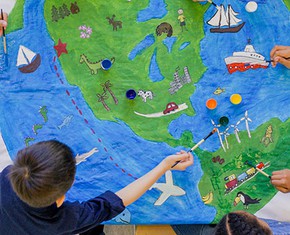The views expressed in our content reflect individual perspectives and do not represent the authoritative views of the Baha'i Faith.
O Thou kind Lord! Thou hast created all humanity from the same stock. Thou hast decreed that all shall belong to the same household. – Abdu’l-Baha, Baha’i Prayers, p. 101.
Let’s take a look, in this essay, at the overall concept of race.
More than a hundred years ago, the Baha’i teachings maintained that God “created all humanity from the same stock.” We know, now, that every human being on the planet truly does belong to one race—the human race. We know that fact scientifically, from DNA studies. We all share the same genus—Homo Sapiens Sapiens—and the same essential physical traits, even though we vary widely in non-essential traits like eye color and height and weight and skin tone.
Want a good example? The shortest adult human alive, Chandra Bahadur Dangi from Nepal, stands 21½ inches tall. A few years ago Mr. Dangi met the world’s tallest man, Sultan Kosen from Turkey, who stands 8 feet 3 inches tall. Despite the enormous variance in their physical stature, both Dangi and Kosen come from the exact same ancestors.
A hummingbird and an eagle are both birds, right? A Chihuahua and an Irish Wolfhound are both dogs. A black horse and a white horse are both horses. In the same exact way, we’re all humans, regardless of our size, our eyes or our skin.
We haven’t always thought about race the way we do now. Actually, humans began categorizing people by race fairly recently, when we started looking at their physical traits and their social groups and giving them a familiar label, usually based on skin color. People with the darkest skin we typically put in the African or “black” category. People with brownish or reddish skin we often assign to the Hispanic or Arab or Indian categories. People with an amber or yellow skin tone become Asians or Pacific Islanders. People with beige or ivory-colored skin generally get classified as “white,” European or Caucasian.
It might surprise you to learn that this kind of classification scheme, this hue-specific taxonomy, didn’t really occur to human beings until the 17th Century, and didn’t come into wide use until the 1800s. Before that, rudimentary biological science didn’t differentiate between people by skin color. Instead, in pre-modern times, people typically were separated into language-based groupings or what were called “folk taxonomies,” popular but unscientific ways of grouping and referring to others.
If you read Shakespeare, you’ll discover several 16th and 17th-Century folk taxonomies. In Shakespeare’s plays, for example, he often referred to people of African descent as “Ethiopes,” because Ethiopia was then the best-known region in Africa. He also referred to people of Arab (or African) descent as “Moors,” because the closest Arabian populations to England were the dark-skinned Moorish and Islamic peoples who once conquered the Iberian Peninsula. Shakespeare probably encountered some Africans in England, since the slave trade had begun by the time he started writing, but “foreigners” were still strange and exotic to most of his countrymen. The great playwright actually made Othello a Moor and the character Aaron in Titus Andronicus an “Ethiope.” Although we might think of Shakespeare as a racist today, because of his largely negative portrayals of dark-skinned characters, he also presented them as people, with a mixture of positive and negative traits.
So now, let’s think about another potential classification scheme: what if we began separating people by height? What if we had a tall race, a medium race and a short race, and they all hated each other? Or what about eye color—if we divided everyone into blue, brown, green and hazel races? Sound absurd? To scientists, those arbitrary divisions are no more absurd than our relatively modern decision to separate and classify people by skin color.
The idea of race, to almost every contemporary scientist, is a total fiction:
What the study of complete genomes from different parts of the world has shown is that even between Africa and Europe, for example, there is not a single absolute genetic difference, meaning no single variant where all Africans have one variant and all Europeans another one, even when recent migration is disregarded. – Svante Pääbo, biologist and director of Germany’s Max Planck Institute for Evolutionary Anthropology.
In other words—we’ve made up any and all racial differences. They aren’t scientific in any way—they’re imaginary. You and I have DNA from indigenous roots somewhere in our history—because everyone does. That means the concept of race based on skin color has no legitimate basis in fact.
The Baha’i teachings agree completely with the science, calling skin color “a mere accident” and an “imagination:”
A man’s heart may be pure and white though his outer skin be black; or his heart be dark and sinful though his racial color is white. The character and purity of the heart is of all importance. The heart illumined by the light of God is nearest and dearest to God, and inasmuch as God has endowed man with such favor that he is called the image of God, this is truly a supreme perfection of attainment, a divine station which is not to be sacrificed by the mere accident of color. – Abdu’l-Baha, The Promulgation of Universal Peace, p. 70.
In the sight of God colour makes no difference at all, He looks at the hearts of men. That which God desires from men is the heart. A black man with a good character is far superior to a white man with a character that is less good. – Abdu’l-Baha, Abdu’l-Baha in London, p. 67.
Strive with heart and soul in order to bring about union and harmony among the white and the black and prove thereby the unity of the Baha’i world wherein distinction of colour findeth no place, but where hearts only are considered. Praise be to God, the hearts of the friends are united and linked together, whether they be from the east or the west, from north or from south, whether they be German, French, Japanese, American, and whether they pertain to the white, the black, the red, the yellow or the brown race. Variations of colour, of land and of race are of no importance in the Baha’i Faith; on the contrary, Baha’i unity overcometh them all and doeth away with all these fancies and imaginations. – Abdu’l-Baha, Selections from the Writings of Abdu’l-Baha, pp. 112-113.
Next: Race: Biologically or Socially Constructed?
















Comments
Sign in or create an account
Continue with Googleor